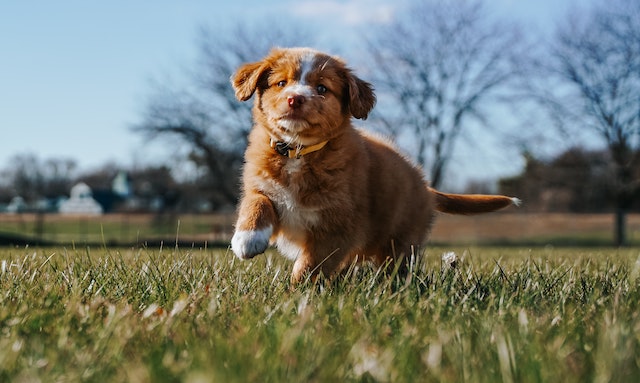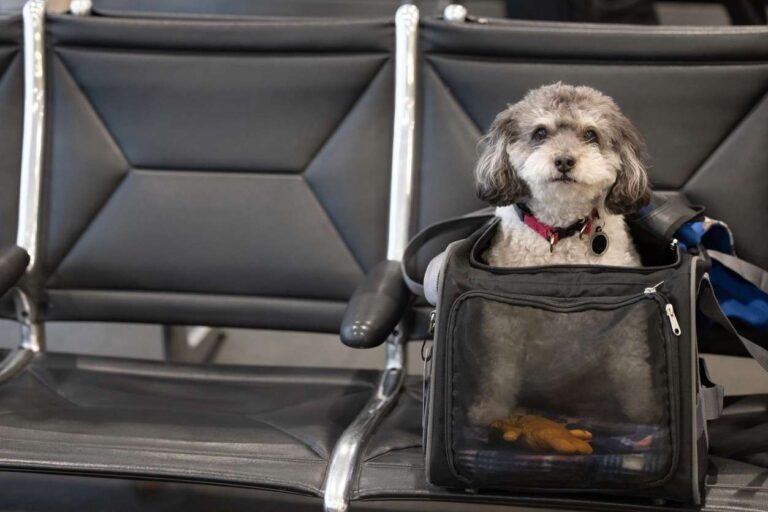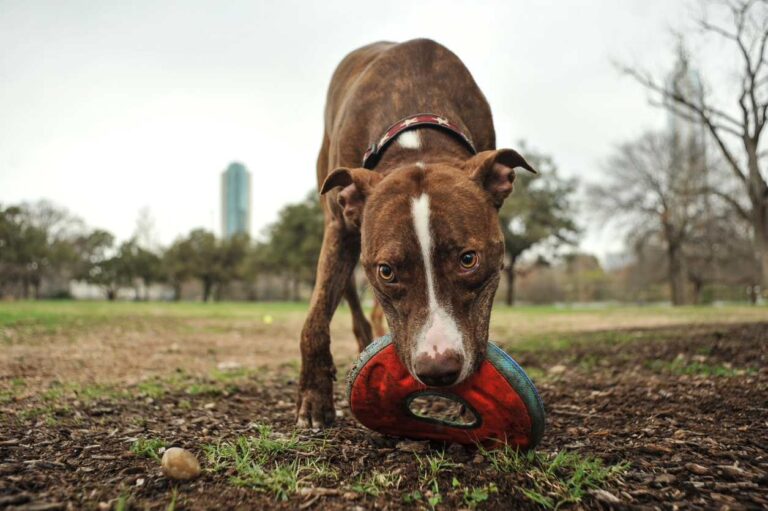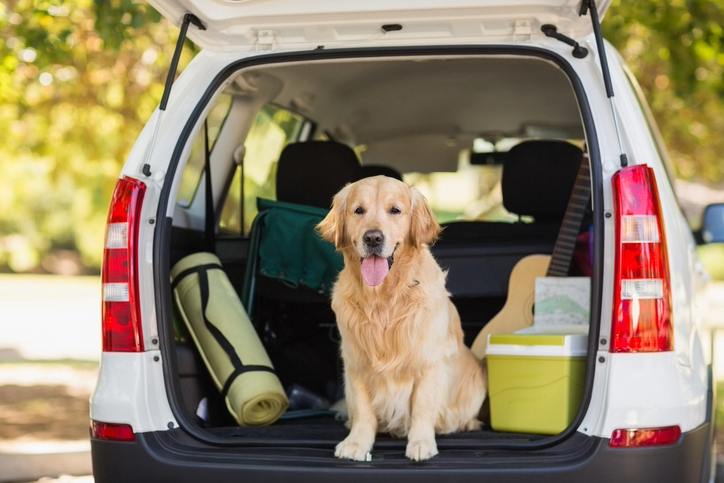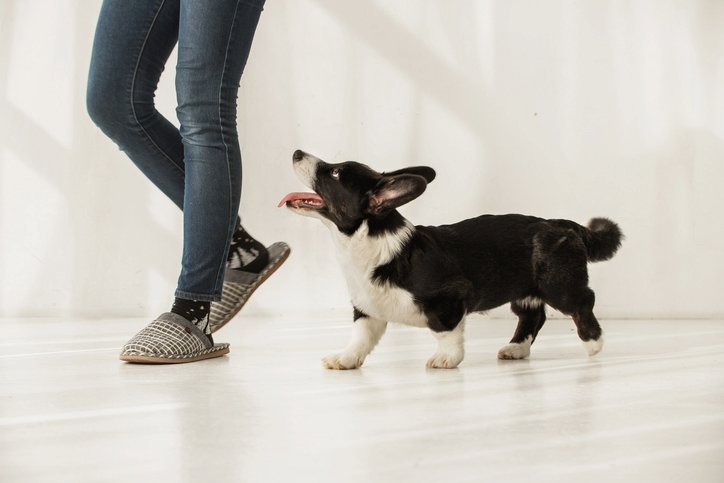One of the most frustrating things, when you bring home your new puppy, is potty training them! Your fluffy new family member may be playful and affectionate, but cleaning up accidents can strain new owners. Housebreaking can feel like the hardest thing in the world when you are in the middle of it, so we wanted to put together some tips and tricks to help potty train your new puppy.
Reputable breeders usually start bringing puppies outside to potty at 5-6 weeks, and foster owners and rescues also work hard to instill a healthy potty training schedule. It is still essential to start training right away as soon as you bring home your new puppy.
Supplies
We recommend a few essentials to ensure the easiest time housebreaking your puppy!
Appropriately sized crate
When you cannot watch your puppy during the day and throughout the night, we recommend purchasing a crate to train your puppy. There are many benefits to crate training, including limiting accidents. The crate should be a wire or molded crate that is secure and large enough for your puppy to stand up and turn around, about one and a half times their length. If it is too big, your puppy will have room to potty and then avoid it, so choosing the correct size is essential. There should be nothing absorbent in the crate or anything they could destroy or ingest. For more information on the different crates, check them out in our “Puppy supply list” blog!
Leash
Your puppy will be dragging a leash when you are home monitoring them, so we recommend a 6” nylon leash.
Treats and treat bag
Training treats are vital for rewarding your puppy when they eliminate outside. Keeping them handy (along with some bags!) in a treat pouch by the door will help get you and your puppy outside as quickly as possible.
*We do not recommend using puppy pads because they tend to encourage pottying on soft, absorbent surfaces, including carpets and blankets. A puppy cannot tell the difference between one absorbent surface and another.
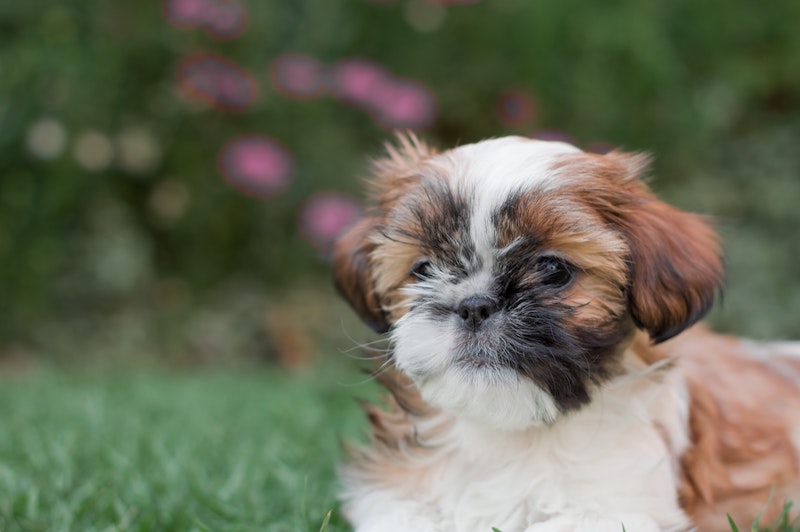
Potty Training Program
The potty training program we use and recommend consists of 4 parts. It takes a lot of work initially, but with diligence and consistency, you can quickly potty train your puppy in as little as a month.
Watch or Confine
A watch or confine program means that when you are not watching your puppy, they are confined to their crate, where no accidents have occurred. You can tether your puppy to your desk when doing work or allow them to drag their leash. Keep them close to you to monitor their movements. The idea is to catch them in the act, and if possible, before they have an accident. Pottying is automatically reinforced, meaning that if your puppy needs to potty and they do, that relief they feel is reinforcing. When your puppy potties in the house without being caught, they are reinforced because they feel better. If you cannot watch them, they need to be confined to avoid an accident.
Food and Water Schedule
Drinking water and eating food stimulates the bladder and bowels, meaning that as soon as your puppy eats or drinks, they will likely have to potty. Keeping them on a strict food and water schedule will also put them on a potty schedule.
Large breed puppies should be able to hold their bladders for the number of months they are, in hours plus one, and for smaller breeds, the number of months they are in hours. For example, a 4-month-old Chihuahua should not have an accident in their crate for 4 hours, and a 5-month Lab should be able to last 6 hours.
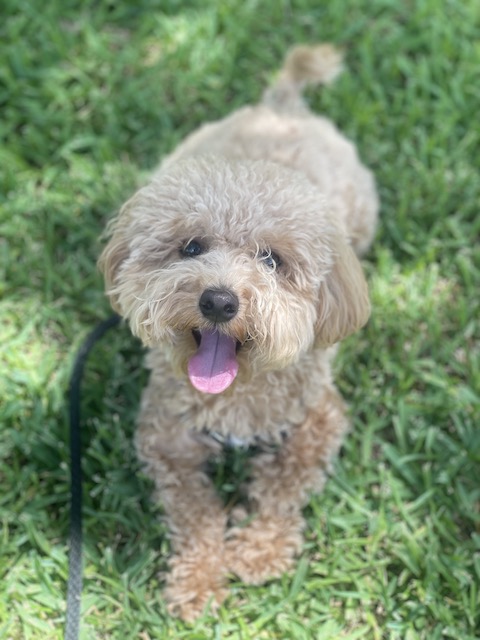
How do you train your puppy to pee outside?
We recommend only allowing your puppy access to water right before they go outside, with the exception being after vigorous playtime or a long walk. This is extremely important for two reasons. First, drinking stimulates the feeling of a full bladder, encouraging them to potty when you take them out. Second, this will also give them their water by the door you use to take them outside so that they associate that feeling with going to the door. This will help them signal that they need to go out by going to that door. Start to give them water access every time you take them out and whenever they go to that spot seeking water. Your puppy should not have access to water anywhere else. Your puppy should be drinking enough water. We just want to manage the environment so that they are not only staying hydrated but starting to associate drinking water with going outside and pottying. Drinking a whole bowl of water will mean he needs to go out again in 20-30 minutes, but a moderate amount of water before he goes out (not when he comes back in) will keep him on schedule. It’s a good rule also to limit water 2 hours before bedtime or if you will be gone for a few hours during the day to decrease the likelihood of accidents.
For meals, puppies digest their food in 6-12 hours, but eating, like drinking, can stimulate your puppy’s urge to go. Follow your veterinarian’s feeding instructions if they have specific needs. Still, we usually recommend feeding them their first meal as early as possible and their last meal as late as possible, but at least 2 hours before putting them in their kennel for bed. For example, if you plan to go to bed at 10 pm, give them their last meal and then their last chance for water at 8 pm, take them out to potty and then take them out one last time at 10 pm before putting them in their crate for the night.
During the night, puppies, depending on their age and size, should be able to last the night without accidents for 6-8 hours. If your puppy cries during the night, we recommend ignoring this behavior because it is most likely attention-seeking crying. If you are worried about them having an accident or working your way up to this amount of time, make sure to let them out when they are not crying. You can even set a time to take them out in the middle of the night before they start crying. Make sure to bring them back to their crate right away afterward. Going outside should not be playtime or cuddle time which may increase their crying because it is more fun than staying in their crate.
We also recommend feeding some or all of their meals on the floor of their crate. This will reduce the likelihood of having an accident in their crate and associate being in their crate with something they like – food!
Reinforce Pottying Outside
Since pottying is automatically reinforced because it feels good, we want to make pottying outside even more reinforcing. This means lots of praise and special treats for pottying outside. To make things easier down the line, we recommend having a potty spot by your home. When you take your puppy out, go to this spot and stay in the area until they potty. We recommend keeping your puppy on a leash so that they do not wander and avoid giving them lots of attention or playing before they potty. Usually, spending 10 minutes, even after they have gone, is a reasonable amount of time to ensure they go. We recommend a place that does not have a lot of dogs and people so they don’t get too distracted and forget to potty.
As soon as your puppy finishes pottying, say “good!” and give them three treats in a row. Make sure not to praise or start to reach for the treats while they are pottying because they might get too excited and stop. Consistently reinforcing eliminating outside is a vital part of the housebreaking process.
If they don’t potty in the 10 minutes, take them back inside, watch them closely and have them drag a leash, then try again in 20 minutes. Repeat until successful.
Catching Your Puppy in an Accident
While making pottying outside significantly reinforcing, we also want to make pottying inside less reinforcing. This means that you need to catch them in the act. Puppies cannot associate punishment for something if it happens more than three seconds after the behavior. This means that if you take a shower and then come out to find an accident on your carpet, it is already too late to punish it. Administering punishments afterward can also associate them doing something good with the punishment. If they potty and then are contentedly chewing on an appropriate chew when you punish them, the wrong behavior will be punished. Timing is so crucial in housebreaking. When you catch your puppy mid-accident, give a very loud verbal “NO!” You can even clap or stomp your foot. You want to make a loud noise to stop them in the act. Then, quickly get them outside and wait for them to finish pottying so that you can praise and treat them for pottying in the correct location.
Monitor, schedule, reinforce and catch those accidents!
Potty training is a difficult part of bringing home a new puppy and can feel even more complicated when you are in the middle of it. The training outlined here takes a lot of work but can lead to fast results if you follow them closely. You will quickly see progress by monitoring them and catching them in the act every time, creating a solid schedule while associating their water with going outside, and enthusiastically reinforcing when they potty outside. After they have gone a month with no accidents, you can start to give them more freedom. If you need any help, please reach out to us! You may even consider a board and train program. We would love to make the housebreaking process as easy as possible.
